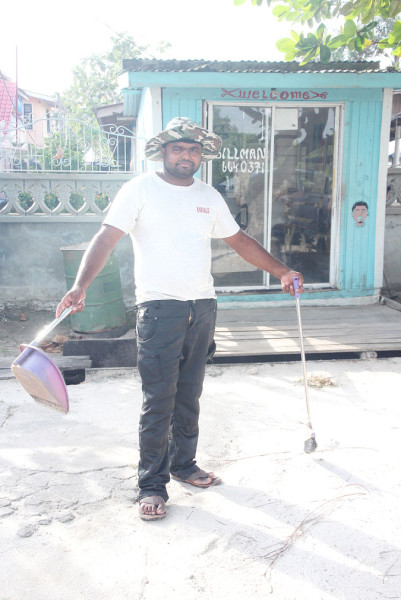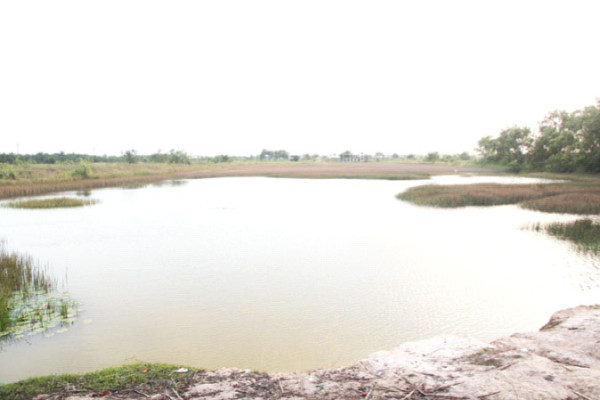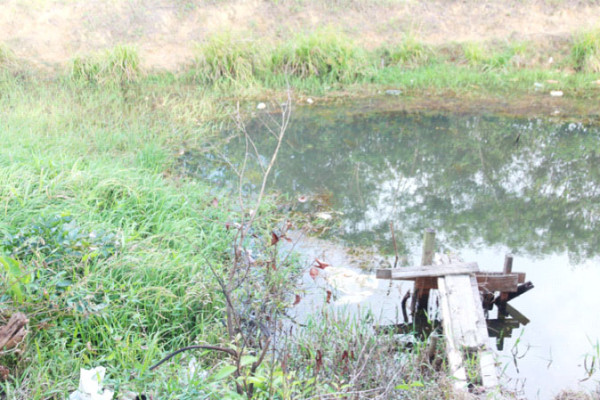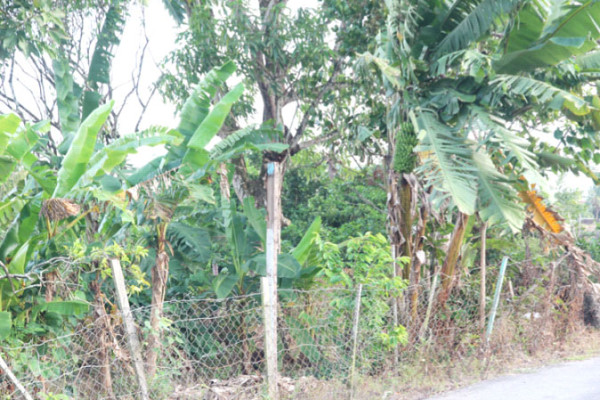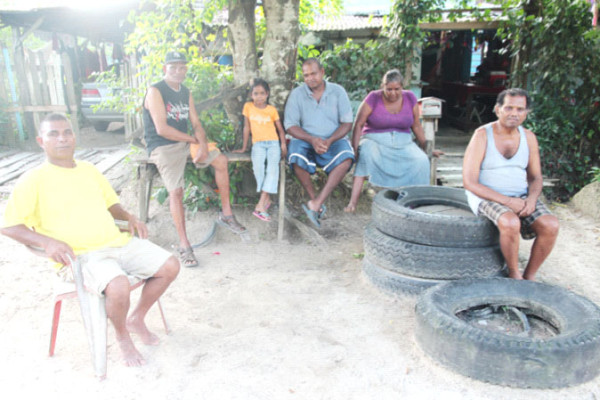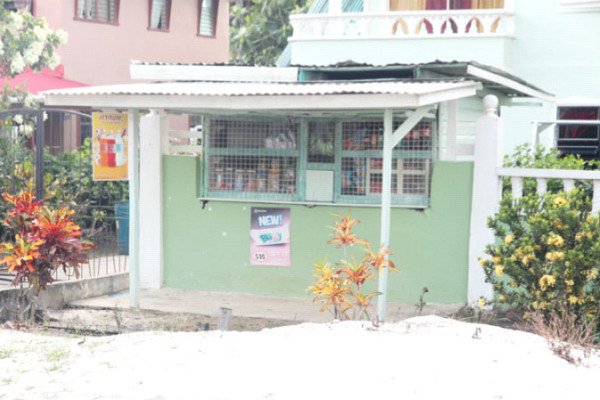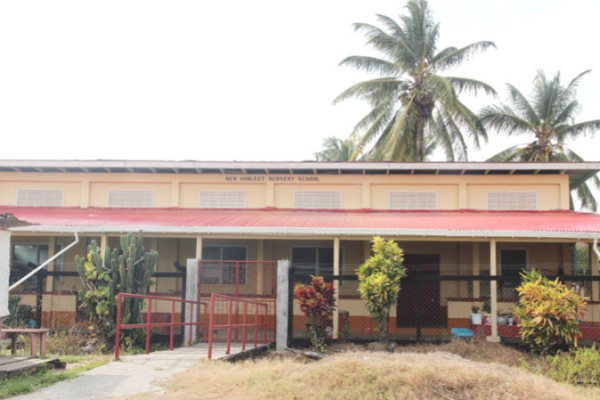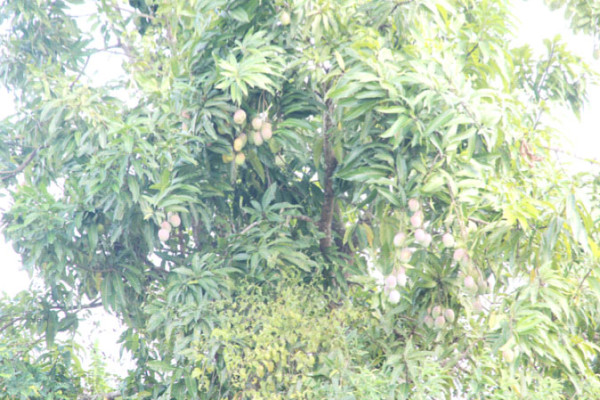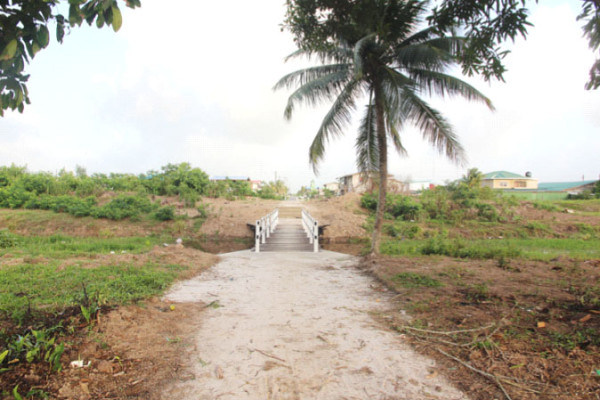Story and photos by Joanna Dhanraj
Edged on both sides by trees and flowering plants is a village situated in Canal Number Two known as Clay Brick Road. The road stretches for a little over one mile with houses lining one side and a canal on the other. The village is home to 500 to 600 residents.
Clay Brick Road is not made of clay brick, but of pitch like any other road. The road was named for the clay brick factory situated at the end of the village. The factory, according to residents, existed in the 1970s. Today it no longer operates.
Dwarka Thakur, who lives in the village, is a former security guard for the Clay Brick Factory and has been a resident in the village for some 25 years now. Thakur was born in Leguan, Essequibo River, and spent most of his boyhood days there before his family moved to Riverview in Georgetown in his late teens. Years later, he moved to Clay Brick.
“I used to rent house. I had two sisters living on the Canal Number Two Public Road. They asked me, ‘Boy how long you go rent?’ So I came and squat here and I’ve been here ever since,” he said. He lives with his wife and daughter in the top flat of his house, while his son and his family live downstairs.
“When I first come here to live, the place was dense, isolated and bushy. I was the fourth person to live in Clay Brick. When I moved here I started working at the Clay Brick Factory as a security guard. The factory existed since the seventies. Five years later I left the job. My son was placed at Bishops’ High after writing Common Entrance. I was being paid a monthly salary. I needed a weekly salary to send him to school every day. I left and started working at Toolsie Persaud.
“I remember when I heard my son got Bishops. I was at Berbice at the time. I was so happy; I come home the next day. After that, whenever I walked on the road [Clay Brick road] I was known as the father of the boy that got the town school,” he said proudly.
Thakur shed a bit of light on the once thriving factory. “The factory made strictly clay brick and nothing else. It was run by GNEC [Guyana National Engineering Corporation]. It closed its doors after the demand for clay brick wasn’t high enough. People were using more of the concrete bricks. Over 100 persons were employed there. At first workers walked the mile long road before reaching the factory. They later bought a big bus.”
Many of the labourers came from villages inside Canal Number Two, but others came from villages outside, such as Wales, Stanleytown, La Retraite, Nismes, Bagotville and La Grange. Although no more in operation, the factory is secured by NICIL.
Many of the villagers here are labourers working at the Wales Sugar Estate; some residents work at private firms in Georgetown. Transportation is taken care of for the sugar workers; they’re taken to and from work by the estate’s trucks. However for other villagers working at private firms, if they don’t have their own mode of transportation, they’re left to walk out of the road until they reach the Canal Number Two Public Road sometimes. Many times the buses traversing the other villages in Canal Number Two would spin into the village early in the mornings to pick up passengers, but when returning in the afternoon, tired and worn out, they’re dropped off at the head of the village and left to walk in.
As we speak, Thakur’s grandson, two-year-old Prateek, plays nearby with his Talking Tom toy that he got for Christmas. He talks to the toy which mimics him. He is the pride and joy of his grandparents and parents.
He stays at home with his mother—an accountant who works from home—and his knowledge tells of her work with him. Although he is only two years old, he boldly answers correctly when his grandmother asks the name of his country, the name of the flag and the names of the president and prime minister.
Today Thakur is back at the Clay Brick Factory working as a security guard. However, he wishes that the factory could be reopened and do some sort of work that could be beneficial to Guyana and at the same time provide jobs for people. He is hoping it could house a training centre maybe. But while he remains in Clay Brick, he says he’ll continue to enjoy the peaceful atmosphere of his community and the joy and pleasure that little Prateek brings him.
Leaving Thakur, the World Beyond Georgetown came across Deokumar Lakhan aka ‘Billman,’ a barber who was cleaning in front of his shop and posed for a photo.
A little further on sits Anantram Narine with his next door neighbour, little Gomattie Ramdeo, in the shade of a tree growing by the roadside. He calls Gomattie’s father, Michael Ramdeo, to join him.
Ramdeo, a weeding and cleaning contractor who works with the Canal Number Two NDC and the Region Three RDC, had more to say on developments he wanted for his community. He has been living here since 1994. Though you’d think that, being a contractor, he’d want the contract to clean the weed and garbage filled trench, his idea for the trench was far from that. Instead, he wants the present government to fill up the trench and have another dug behind the houses.
According to Ramdeo, there are two trenches in front of them and there’s no need for that. The two trenches that are separated by a broad dam also separate Clay Brick from the nearby village, Belle West. He added that should the trench be filled along with the government reserve that many of the villagers use for planting, there would be enough land space for housing, thereby providing persons with house lots and making Clay Brick a brighter village.
Another of his concerns is the Clay Brick road. After dark and even during the day, he said, drivers use the road as a race track. Two weeks ago a farmer lost his ox in a crash on the road. According to him the animal was used to plough the farms. The owner he said would often be contracted for the use of his ox and the recent accident left him looking for a job. Ramdeo would like the road to have at least two speed bumps.
He also mentioned that he’d like the torn down bus shed that was situated on the Canal Number Two Public Road to be replaced. Residents walking out of Clay Brick and other illages would often wait for transportation under the shed but now are left to stand in the rain or sun. The bus shed was damaged after bandits escaping the police drove into it. The bandits had robbed a resident from a village in Canal Number One Polder. The Canal Number Two NDC pulled it down a few months ago.
He too wants the Clay Brick factory to reopen even if it’s just for making concrete blocks so that jobs can be provided. He also said that he would like the electricity poles grounded in people’s yards to be removed. Ramdeo said the former CEO of GPL, Bharat Dindyal had made promises almost seven years ago that he’d try to do something about it, but the situation has remained the same.
Finally he’d like the residents of Clay Brick to be allowed to pay their property rates, so that the village could become more developed.
Farmer, Mohammed Rasheed and his two sons had just returned from their farm. Rasheed is also the chairman of the farmers’ group in Canal Number Two. He was born in Canal Number Two but left for Enterprise with his father and the rest of their family when he was little. They returned to live in Canal Number Two after his father bought a five-acre plot of land for $80, which back then represented more than a year’s savings. “We come back to farm seven miles into the Canal Number Two Conservancy then we see people start to squat and we come and squat too. The place [Clay Brick Road] is peaceful,” he said.
Rasheed lives with his wife and two sons. His farm is situated way beyond Clay Brick Road, past the Clay Brick Factory and the once famous Blue Water Creek. He plants cabbage, tomato, banana, plantain and many other fruits and vegetables. “We depend on agriculture,” he said.
The Christmas holiday saw him in the farm. “Farming you don’t get holiday,” he added. He sells wholesale to vendors living in Canal Number Two.
“When I had occupied this land and started farming in 2000, I used to get severe flooding. The previous government provided us with a drainage pump in 2014. The pump is situated in Patentia and drains off the farmlands,” the farmer said. Before the pump was installed, Rasheed had to pump water out of the farm when it flooded and sometimes even slept at the farm since he’d have to pump the water out every two hours.
The trench at the back that Ramdeo said he would like to see was once started according to Rasheed. “We started digging but a few persons who had their fence right up refused to move their fences. A trench at the back would have been better sanitation for us,” he said.
“I like living here. The people peaceful. You get the cooperation from the villagers,” he added.


